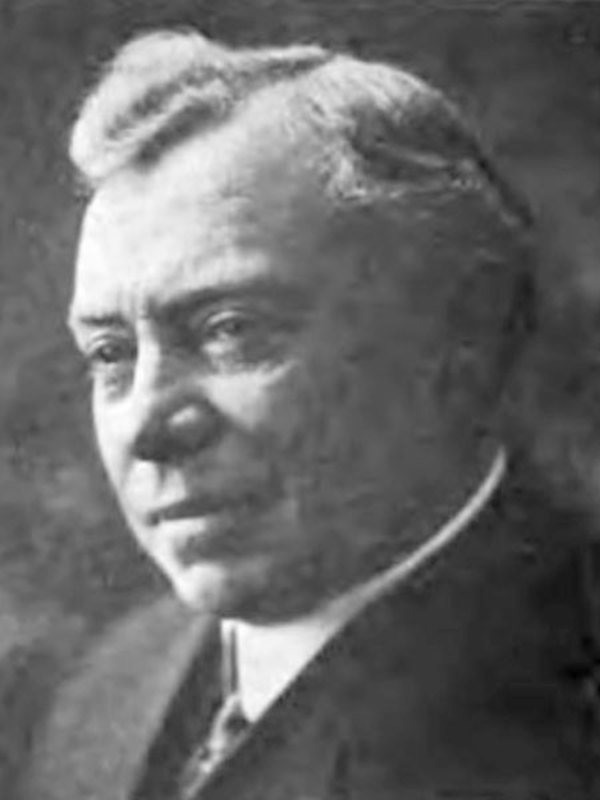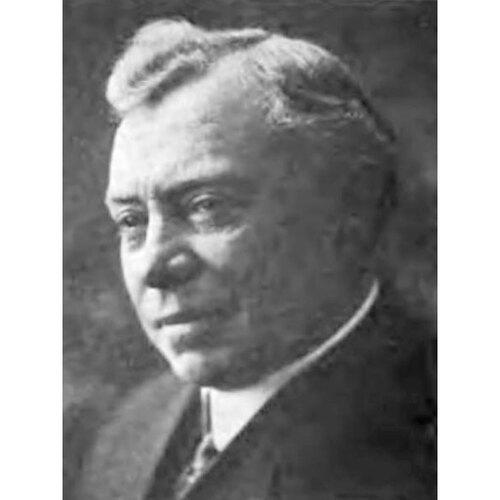
Source: Link
SULLIVAN, JOHN GODFREY, engineer, alderman, and university lecturer; b. 11 Jan. 1863 in Bushnell’s Basin, Perinton, N.Y., son of Thomas Sullivan and Honora (Hanora) Doody; m. 24 April 1894 Sarah Ann Farrell in Ovid, N.Y., and they had two daughters and two sons; d. 7 Aug. 1938 in Winnipeg.
John Godfrey Sullivan graduated from high school in the village of Fairport, near his birthplace, before attending Cornell University in Ithaca, where he received a civil-engineering degree in June 1888. He began his professional career one month later as a rodman with the Great Northern Railroad (GNR) in the Montana Territory. In the spring of 1889 he was hired by the Spokane Falls and Northern Railway in the Washington Territory and advanced to the position of assistant engineer. He left to work for the GNR on its Pacific Extension to Seattle, Wash., in the fall of the next year.
Sullivan first came to Canada in July 1893 to take up the post of assistant engineer for the Alberta Railway and Coal Company [see Sir Alexander Tilloch Galt*] based in Lethbridge. The following year a strike brought construction to a halt, and he returned to the United States in October. He was employed by several railways in the northwest over the next six years. He worked in Montana, first as a section foreman for the Northern Pacific Railroad for a few months, and then as a locating engineer on the Butte, Anaconda, and Pacific Railway. In the spring of 1895 he moved to British Columbia to serve as principal assistant engineer on the Kaslo and Slocan Railway [see John Hendry*]. He became reconnaissance engineer the following year, and then from 1898 to 1900 he worked as principal assistant engineer for the Columbia and Western Railway in the Rossland area, where he gained experience in tunnelling. From 1900 to 1905 he was the division engineer of construction for the Canadian Pacific Railway (CPR), in charge of surveys and the building of all new rail lines west of Fort William (Thunder Bay), Ont.
Sullivan was naturalized as a British subject in 1905. From September of that year to January 1907 he was assistant chief engineer (and for three months acting chief engineer) of the Panama Canal, engaged mainly in excavating the Culebra Cut. He made improvements to the original design of the Lidgerwood Manufacturing Company’s slide plough, which increased its efficiency, thereby saving millions. In February 1907 he moved to Montreal and became manager of construction, and the next year assistant chief engineer, for the CPR’s eastern lines. Transferred to Winnipeg in February 1911 as assistant chief engineer for the western lines, he was promoted chief engineer within eight months. Four years later he was named chief engineer of the entire CPR. In 1916, while still a CPR employee, he served on the board of engineers that examined the design of the Greater Winnipeg Water District’s aqueduct [see Henry Norlande Ruttan*], which would supply the area with fresh water from Shoal Lake, Ont.
In 1916 the construction of the Connaught Tunnel in British Columbia’s Selkirk Mountains won Sullivan international attention. Between 1910 and 1913, aware of increasing rail traffic and potential competition from rivals such as the Grand Trunk Pacific and the Canadian Northern railways [see Charles Melville Hays*], the CPR had decided to double-track its line from Calgary to Vancouver. A tunnel would remove bottlenecks on the surface line at Rogers Pass, and in his October 1912 study, Sullivan projected that there would be significant savings if one could be blasted through the mountain. The contract was awarded to Foley, Welch, and Stewart [see John William Stewart] on 1 July 1913, with a deadline of three and a half years. As chief engineer on the project, Sullivan worked closely with the company’s superintendent, A. C. Dennis. Breaking with engineering precedent, Sullivan rejected the high labour costs associated with both the European method of tunnelling and the slower American approach. Instead, he accepted and then modified Dennis’s plan. They first bore a small eight- by eleven-foot preliminary working tunnel, or pioneer heading, through the heart of Mount Macdonald parallel to the centre line of the projected tunnel, and then blasted rings through solid rock to create the main tunnel. This never-attempted technique sped up construction by facilitating the tunnel’s progress without disrupting work elsewhere. Although the achievement was overshadowed by the First World War, it was applauded by engineers. The five-mile double-track tunnel was completed 11 months ahead of schedule and cost about half the initial estimate of $12 million. Regular trains began using it on 9 Dec. 1916. Named after the Duke of Connaught [Arthur*], governor general of Canada from 1911 to 1916, it was the longest tunnel in North America at the time. It lowered the gradient of the track by decreasing the summit elevation by 552 feet, shortened the line, and eliminated the need for snow-sheds to protect workers and equipment from heavy snowfalls and avalanches.
Two years after the completion of the Connaught Tunnel, Sullivan resigned from the CPR, but he was retained in an advisory capacity until 1927. From 1918 to 1935 he practised as a consulting engineer. Recognized internationally as an authority on railway location, he reported on a variety of important engineering projects and arbitrated labour and railway disputes. In 1919 he studied a proposed Manitoba government scheme for distributing electrical power. He was chairman of the Manitoba Drainage Commission (also known as the Sullivan commission) from 1919 to 1922, which developed a land-drainage solution for the Red River valley.
The federal government retained Sullivan during its arbitration with the Grand Trunk Railway (1920–21). He provided information to the premier of British Columbia on the physical-engineering aspects of the Pacific Great Eastern Railway and headed a dominion government survey to locate a railway outlet for the Peace River valley in 1922. The following year he was a member of a commission that advised the Manitoba government on its hydroelectric system. In 1924 he was president of the Canadian Engineering and Construction Company in Winnipeg and the firm of Sullivan, Kipp, and Chace, which he had co-founded that year; he would retain both posts until his death.
Sullivan’s consulting work outside Canada included a report on the location of a rail line between Cincinnati, Ohio, and Chattanooga, Tenn., in 1924. The next year he was a consultant to a British engineering firm on a proposed vehicular tunnel between Liverpool and Birkenhead. He reported to the Denver and Salt Lake Railway in 1926 on ventilating the Moffat Tunnel in Colorado.
During the Winnipeg civic election campaign of 1919, Sullivan had entered the bitter class-polarized politics of the period following the Winnipeg General Strike [see Mike Sokolowiski*]. He was backed by Sir Augustus Meredith Nanton* and other members of the pro-business Citizens’ Committee of One Thousand. To avoid splitting the vote, incumbent alderman Isaac Cockburn stepped down in favour of Sullivan, who was elected alderman for the generally affluent Ward 1. Able and outspoken, he served for four terms until 1927.
Sullivan had joined the American Society of Civil Engineers in 1899 and the American Railway Engineering Association around 1914 (he was president four years later). In 1900 he became a member of the Canadian Society of Civil Engineers, which had been founded by Alan Macdougall* and others in 1887; it would reorganize as the Engineering Institute of Canada (EIC) in 1918. Sullivan served on its council in 1910 and 1918. He was vice-president from 1911 to 1913 and president in 1922 when the organization lobbied several provinces to establish licensing for engineers to place them on the same legal footing as lawyers and physicians. In this respect, Sullivan was a major figure in the development of the professions in Canada.
For more than 15 years Sullivan was a prominent member of the Winnipeg Branch of the Rotary Club. He also belonged to the city’s Manitoba Club and St Charles Country Club as well as Montreal’s St James Club. A Roman Catholic, he was a life member of the Knights of Columbus. He taught engineering courses at the University of Manitoba, and in May 1936 that institution conferred upon him an honorary lld. The same year he received the EIC’s highest award, the Sir John Kennedy Medal. Sullivan died at his home in Winnipeg at the age of 75 after a long illness. The Winnipeg Free Press wrote that “no man who has the Connaught Tunnel as his memorial will ever be forgotten in Western Canada.”
John Godfrey Sullivan’s publications include Spiral tables, prepared for the Canadian Pacific Railroad (New York, 1908), and Report on the engineering and economic features of the Pacific Great Eastern Railway (Victoria, 1922). His presidential address to the Engineering Instit. of Can. (EIC) appeared in the Engineering Journal (Montreal), 5 (1922): 485–86. His 1900 application to the Canadian Soc. of Civil Engineers (later EIC) can be found at LAC, MG28-I277 (Engineering Instit. of Can. fonds, membership files, pre 1920), vol.19, John G. Sullivan, Form A. It encloses his curriculum vitae for the period 1863–1923 and a typescript article, “John G. Sullivan, , president, the Engineering Institute of Canada,” which was published in the Engineering Journal, 5 (1922): 87. The longest description of Sullivan’s career is in “John G. Sullivan, ,” Engineering Journal, 21 (1938): 439–40. Obituaries include: Canadian Engineer (Toronto), 16 Aug. 1938: 24, 26; Canadian Transportation (Toronto), 41 (1938): 450; Railway Engineering and Maintenance (Chicago), September 1938: 559; the Winnipeg Free Press, 9 Aug. 1938; and the Winnipeg Tribune, 8 Aug. 1938.
For the innovative construction methods employed on the Connaught Tunnel, see: J. G. Sullivan, “Methods adopted in the construction of Rogers Pass Tunnel,” Canadian Soc. of Civil Engineers, Trans. (Montreal), 30 (1916): 129–34 (an abstract of this paper appears in the Canadian Engineer, 20 April 1916: 467–69); and A. C. Dennis, “Construction methods for Rogers Pass Tunnel,” Canadian Engineer, 1 March 1917: 189–92. Other contemporary articles include: “The Rogers Pass Tunnel,” Engineering News (New York), 2 April 1914: 718–19; “Roger’s [sic] Pass Tunnel in the Selkirks,” Canadian Engineer, 26 Aug. 1915: 295–96; “Tunneling at Roger’s [sic] Pass,” Canadian Engineer, 10 Feb. 1916: 232; and “Progress in the art of tunneling,” Engineering News, 11 Jan. 1917: 77. A good analysis of the decision to build the tunnel is G. G. Backler and T. D. Heaver, “The timing of a major investment in railway capacity: CPR’s 1913 Connaught Tunnel decision,” Business Hist. (London), 24 (1982): 300–14.
Cite This Article
J. Rodney Millard, “SULLIVAN, JOHN GODFREY,” in Dictionary of Canadian Biography, vol. 16, University of Toronto/Université Laval, 2003–, accessed December 31, 2025, https://www.biographi.ca/en/bio/sullivan_john_godfrey_16E.html.
The citation above shows the format for footnotes and endnotes according to the Chicago manual of style (16th edition). Information to be used in other citation formats:
| Permalink: | https://www.biographi.ca/en/bio/sullivan_john_godfrey_16E.html |
| Author of Article: | J. Rodney Millard |
| Title of Article: | SULLIVAN, JOHN GODFREY |
| Publication Name: | Dictionary of Canadian Biography, vol. 16 |
| Publisher: | University of Toronto/Université Laval |
| Year of publication: | 2022 |
| Year of revision: | 2022 |
| Access Date: | December 31, 2025 |



